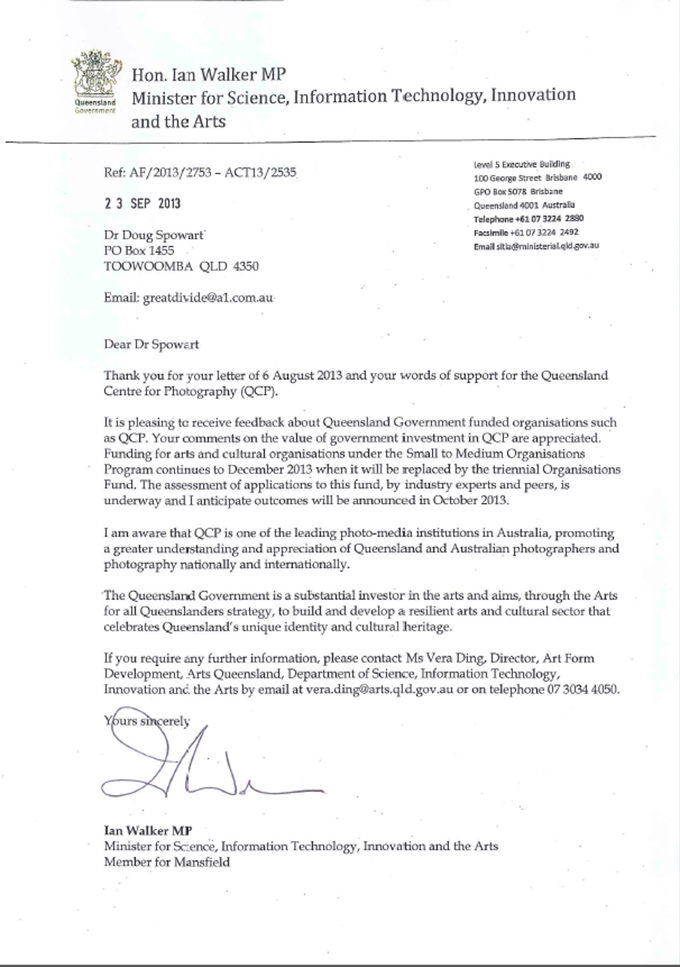Posts Tagged ‘Maurice Ortega’
‘Our Home on the Range’ exhibition @ QCP
.
DOUG CURATES QCP STUDENT EXHIBITION: “Our Home on the Range”
Southern Queensland Institute of TAFE Certificate IV in Photoimaging students recently presented their work in Brisbane as part of the Queensland Centre for Photography’s Undergraduate Bridging Program. The images in the series “Our Home on the Range” are indicative of the intention for the program to allow students to develop both creative and personal directions in their studies. Throughout 2013 the exhibiting photographers have worked with teachers Alison Ahlhaus, Sheryleigh Burns, Bev Lacey, Rachel Susa and Doug Spowart. The exhibition was curated by Doug Spowart.
The QCP Undergraduate Photo Media Bridging Program profiles the work of emerging artists who are currently studying photo media at an Australian higher learning institution. The program provides a bridge between higher learning institutions, students and the QCP, providing an insight into work currently being produced by undergraduates recognising the outstanding cultural investment made by institutions and lecturers across Australia.
.
.
Here is a gallery of the Our Home on the Range photographs …
.
.
.
Thank you to the Queensland Centre for Photography for the support to these emerging photographers.
.
.
Copyright in the photographs remains with the the photographers.
Queensland Centre for Photography Continued Arts Qld Funding: A letter to the Minister
SEE UPDATE ON FUNDING: https://wotwedid.wordpress.com/2013/11/11/qcp-funding-cut-statement-from-the-qcp-board/
Beyond everything else in contemporary life we all need creative stimulation and engagement with things bigger than ourselves – Photography does that better than just about anything else, and the QCP is the most important centre of photographic thought and activity in Queensland, and perhaps even Australia. We need this organisation to be supported by private and public institutions to match the acclaim and recognition that it has rightfully earned through darn hard work and its dedication to artists and those who appreciate the beauty, and the expression, that can be found and shared through the photograph.
The QCP funding provided by the Queensland Government through Arts Queensland is about to be reviewed. Over the last few months the QCP and its supporters have been gathering evidence of their activities and the important and necessary service that they provide to photographers and the photographically interested public in Queensland. Despite the support that the QCP gains from private donors, the income derived from exhibitions and publications and other activities, as well as substantial in-kind volunteer support, the additional funding provided by AQ enables so much more to be achieved.
QCP Director Maurice Ortega contacted me in July to provide a personal support letter to the minister – the text of which is listed below. Recently I have received a response from the minister, which I have attached for your information.
You can support the QCP by adding your name to the online petition that is listed below – but be quick, as the numbers need to be tallied soon.
.
.
A LETTER TO THE MINISTER SUPPORTING THE QCP
.
August 6, 2013
.
The Honourable Ian Walker
Minister for Science, Information Technology, Innovation and the Arts
Level 5, Executive Building
100 George Street
BRISBANE QLD 4000
.
Subject: A letter of support for the Queensland Centre for Photography
.
Dear Minister,
In 1980 I co-founded with my mother Ruby a facility in Brisbane to provide a focus for the people of Queensland who were interested in all facets of photography. This included: exhibitions, their display and curatorship; a training and workshop facility; and a meeting place. The gallery was called Imagery and operated essentially as an artists-run initiative until 1995. The activities of Imagery Gallery were considered so significant that its complete archive was accepted by the State Library of Queensland, and as such, has become part of the history of this state.
In 2004, a proactive group of academics and practitioners, recognising the absence of a dedicated facility like Imagery for the support and development of photography in Queensland, founded the Queensland Centre for Photography (QCP). Over the nine years of operation, the managing team headed by Director Maurice Ortega and Deputy-Director Camilla Birkeland, have developed the QCP into an internationally recognized centre for the art of photography.
The costs associated with the QCP operation not only comes from government grant funding but also through the valuable support of corporate sponsors and the work of an energetic committee of volunteers and interns.
QCP initiatives include the following key programs:
- The exhibition program
- The educational program
- The publication program
- The international program
- The QCP collection
- The biennial Queensland Festival of Photography.
With the biennial Queensland Festival of Photography (QFP) the QCP gathered together a statewide coverage of exhibition venues and the QFP travelling series of lectures and forums placed the organisation’s commitment firmly within the regional space of Queensland. Further to this they have taken Queensland photographers and their works to international venues and gained significant recognition for Queensland themes and stories.
I am a regional artist, a TAFE teacher of photography, a critic and commentator on art and photography, and a member of many photography organizations including the Australian Institute of Professional Photography with service as chair of national subcommittees. It is my opinion that the QCP’s contribution to the practice and art of photography is significant and vital to the fabric of cultural activity and its growth in Queensland.
Photography today is ubiquitous; it permeates every aspect of society, every age group and interest. People employ photography in science, in information and communication technology. Most importantly photography is universally the medium of story telling and the QCP’s activities across the state provide support for Queenslanders to create and present these communiqués to national and international audiences.
The Queensland Centre for Photography has made a proven contribution to the state of Queensland in supporting and fostering the important practice and art that is photography and its contribution to cultural development. I therefore ask that you positively consider the ongoing support funding to enable this important Queensland initiative to continue doing its work for Queenslanders into the future.
Yours faithfully
.
Dr Doug Spowart M.Photog, FAIPP, HonFAIPP
.
.
.
PHOTO TREASURE: The QCPs ‘Treasures: The art of collecting’
REVIEW: Treasures: The art of collecting
.
I’m an obsessive collector. It’s a big problem because I’m finding it difficult to store everything …
Martin Parr talking about his book collection 1.
Collecting photographs and collecting collections is the subject of the current exhibition at the Queensland Centre of Photography. 72 photographic works on loan from 23 collections both significant and personal, fill the exhibition space. The works represent a wide selection of the history of the medium, the range of themes pursued by photographers and the stuff that collectors collect.
The exhibition was curated by QCP Director Maurice Ortega and was drawn from the contacts, colleagues and members of the QCP fraternity. Works from significant collectors like Daryl Hewson and Fred Hunt were prominently featured in the show. Other works came from the QCP’s own collection, many of which have interesting provenance, were gifts to the Centre, or to members of QCP photography fair delegations travelling overseas.
Each work has a unique story not only of the photograph’s making but also of the collector’s possession and the story of ownership. To pass on these dual narratives each work is accompanied by a comprehensive didactic panel that provides a connection with why the work was collected and its meaningfulness for the collector.
.
On Sunday 14th April Maurice Ortega gave a floor talk about the Treasures. He discussed the idea and practice of collecting generally and then walked through the space drawing attention to selected works–their owners and any special stories around their provenance.
Ortega spoke of the importance of collectors and how they can support artists at all levels of their careers. He noted that in Australia so many art photographers make a fine start in their professional practice but so often slip from view due to the inability for them to derive sufficient income to survive. He lamented the lack of a passion for collecting within Australia citing the success of the American scene. A video presentation in the gallery shows, as an example, the collection of Steven Reinstein and it’s presentation within a home. It is a grand statement about how ‘amazing’ the personal accumulation of art can be.
In Ortega’s catalogue statement he pays great respect to the collector by stating that:
… collectors of every kind should be celebrated and emulated; first for directly supporting the artist, second for maintaining cultural diversity and thirdly for keeping art thoroughly democratic by keeping it grounded on its domestic domain, that of everyday life.
The Treasures exhibition may be a significant look into the art of collecting but it has many other valuable outcomes. It presents to visitors an array of photographic materials, techniques, themes and makers, the like of which has not been shown in this region for some time. It highlights the importance of collection and possession and the link that it provides for a supporting structure within art photography. And it must also surprise the viewer of the exhibition with the spectacular range of art photography that exists out in the wilds of the private collector.
Furthermore this exhibition is a curatorial tour de force and is an example of the significant role that the QCP plays within Queensland–perhaps even Australia, in the provision of true and relevant exhibitions of what the art of photography is, and what can be…
.
Dr Doug Spowart
For images and more details of the exhibition SEE http://www.qcp.org.au/exhibitions/current/album-791/28
A personal postscript: Like Martin Parr I’m an obsessive collector of photographs, photographica, photobooks and photo ephemera. I was asked by Maurice for a piece from my collection for the Treasures show–I selected a calotype print made from a Henry Fox Talbot negative c1843. Printed by author, historian and Kodak Museum Curator Brian Coe in 1976. The provenance of the photograph was that it was an award won by me in the Kodak International of Photography in that year. Due to difficult display requirements it was decided not to include the work in the Treasures show.
1. Badger, G 2003, Collecting Photography, Mitchell Beazley Ltd., London.
.
Images of the exhibition installation and text by Doug Spowart .
This work is licensed under a Creative Commons Attribution-NonCommercial-NoDerivs 3.0 Unported License.
.























